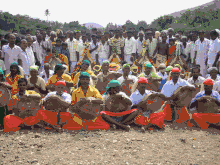Kurumba (tribe)
Kurumbas (or) Kurumbar (Tamil: Kurumban, Kurumbar) (Malayalam: Kuruman) (Kannada: Kuruba, Kurubaru) are a designated Scheduled Tribe or an indigenous community in the Indian states of Karnataka, Kerala and Tamil Nadu.[2] The Kurumbar are one of the earliest known inhabitants of the Western Ghats, who are engaged in the collection and gathering of forest produce, mainly wild honey and wax. The members of this community are short, have dark skin, and have protruding foreheads.[3]
| Total population | |
|---|---|
| 88,750[1] (2011 census) | |
| Regions with significant populations | |
| Kerala, Karnataka, Tamil Nadu | |
| Languages | |
| Kurumba languages | |
| Religion | |
| Animism, Hinduism | |
| Related ethnic groups | |
| Dravidians, Tamil |
Kurumbar are partially Sanskritized to believing in Hinduism. The main deity of the tribe is Lord Shiva under the name of Bhairava. They also worship animals, birds, trees, rock hillocks, and snakes, along with the other Hindu deities.
There are several divisions of Kurumba: Jenu, Betta and Alu. Each of these divisions speaks their own Dravidian language. Jenu Kurubas are primarily found in the northern part of the Nilgiris, in the Mysuru district of Karnataka.
Kurumbar are one of the six ancient tribal groups in Tamil Nadu. According to the Madras Census Report of 1891, the Pallavas were Kurumbas.[4] Hunting and collecting forest produce are the two main means of living for the Kurumbar tribe. However, the restrictions to protect native forest and wildlife have forced them to find work outside the forests.

References
- "A-11 Individual Scheduled Tribe Primary Census Abstract Data and its Appendix". www.censusindia.gov.in. Office of the Registrar General & Census Commissioner, India. Retrieved 2017-11-03.
- "List of notified Scheduled Tribes" (PDF). Census India. pp. 26–27. Archived from the original (PDF) on 7 November 2013. Retrieved 15 December 2013.
- பழங்குடியினர் மொழிக்கான அகராதி தயாரித்த ஆசிரியைகள்: அரசு அங்கீகரிக்க சமூக ஆர்வலர்கள் கோரிக்கை- The Hindu Tamil News - 20 September 2016
- H.V. Nanjundayya; L.K. Anathakrishna (1988). The Mysore tribes and castes, Vol 4. Mysore, Mysore University. p. 30. OCLC 830766457.
They (the Kurubas) are the modern representatives of the ancient Kurumbas or Pallavas, who were once so powerful, throughout South India, but very little trace of their greatness now remains. In the seventh century, the power of the Pallava kings seems to have been at its zenith, but shortly after this, the Kongu, Chola and Chalukya chiefs succeeded in seyeral victories over them. The final overthrow of the Kurumba sovereignty was effected by the Chola king Adondai about the 7th or the 8th century A.D., and the 'Kurumbas were scattered far and wide.